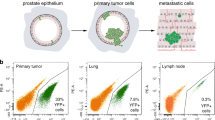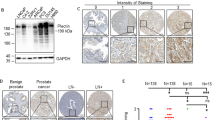Abstract
Prostate cancer continues to be a significant cause of death in U.S. men despite screening of asymptomatic men and extensive treatment with potentially curative therapies, predominantly radical prostatectomy and irradiation therapy. The reason for the persistent mortality resides in part in the presence of occult metastases at the time of treatment. Currently there are no curative therapies for metastatic prostate cancer. To better understand the metastatic phenotype in prostate cancer, we developed a strategy to compare and isolate mRNAs that are expressed differentially in cell lines derived from primary versus metastatic mouse prostate cancer using differential display-PCR. This strategy has proven to be successful and multiple gene sequences associated with metastasis in this model are being investigated. One of the genes isolated by this method was caveolin-1. Caveolin-1 was found to be overexpressed not only in metastatic mouse prostate cancer, but also human metastatic disease. Recent studies have indicated that suppression of caveolin expression induces androgen sensitivity in high-caveolin, androgen-insensitive mouse prostate cancer cells derived from metastases. Overexpression of caveolin leads to androgen insensitivity in low-caveolin, androgen-sensitive mouse prostate cancer cells. Caveolin-1, therefore, is a metastasis-related gene and a candidate gene for hormone-resistant prostate cancer in man.
Similar content being viewed by others
References
Parker SL, Tong T, Bolden S, Wingo PA: Cancer statistics, 1997. CA Cancer J Clin 47: 5-27, 1997
Lu-Yao GL, McLarren D, Wasson J, Wennberg JE: An assessment of radical prostatectomy time trends, geographic variation and outcomes. The prostate patient outcomes research Team. JAMA 269: 2633-2636, 1993
Surveillance, Epidemiology, and End Results (SEER) Program. Age-adjusted U.S. cancer death rates. J Natl Inst 89: 12, 1997
Ohori M, Wheeler TM, Kattan MW, Goto Y, Scardino PT: Prognostic significance of positive surgical margins in radical prostatectomy specimens. J Urol 154:1818-1824, 1995
Zeitman AL, Edelstein RA, Coen JJ, Babayan RK, Krane RJ: Radical prostatectomy for adenocarcinoma of the prostate: The influence of preoperative and pathologic findings on biochemical disease-free outcome. Urology 43: 828-833, 1994
Sakr WA, Macoska JA, Benson PD, et al.: Allelic loss in locally metastatic, multi-sampled prostate cancer. J Urol 54: 3273-3279, 1994
Qian J, Bostwick DG, Takashi S, et al.: Chromosomal anomalies in prostatic intraepithelial neoplasia and carcinoma detected by fluorescence in situhybridization. Cancer Res 55: 5408-5414, 1995
Thompson TC, Park SH, Timme RL, et al.: Loss of p53 function leads to metastasis in ras+myc-initiated mouse prostate cancer. Oncogene 10: 869-879, 1995
Kinzler K, Vogelstein B: Lessons from hereditary colorectal cancer. Cell 87: 159-170, 1996
Thompson TC, Timme TL, Sehgal I: Oncogenes, growth factors, and hormones in prostate cancer. In Hormones and Growth Factors in Development and Neoplasia. Dickson RB, Salomon DS, (eds), John Wiley and Sons, Inc, New York, 1998
Thompson TC, Timme TL, Sehgal I: The role of p53 in prostate cancer progression. In Accomplishments in Cancer Research, 1996. Fortner JG, Sharp PA, (eds), Lippincott-Raven, Philadelphia: 280-289, 1996
Hall SJ, Thompson TC: Spontaneous metastatic activities but not experimental metastatic activities differentiate primary tumor-derived versus metastasis-derived mouse prostate cancer cell lines. Clin Exp Metastasis 15: 484-493, 1997
Yang G, Truong LD, Timme TL, Ren C, Wheeler TM, Park SH, Nasu Y, Scardino PT, Thompson TC: Elevated expression of caveolin is associated with progression in prostate and breast cancer. Clin Cancer Res 4: 1873-1880, 1998
Harder T, Simons K: Caveolae, DIGs, and the dynamics of sphingolipid-cholesterol microdomains. Curr Opin Cell Biol 9: 534-542, 1997
Nasu Y, Timme TL, Yang G, Bangma CH, Li L, Ren C, Park SH, DeLeon M, Wang J, Thompson TC: Suppression of caveolin expression induces androgen sensitivity in metastatic androgen insensitive mouse prostate cancer cells. Nature Med 4: 1062-1064, 1998
Engelman JA, Wykoff CC, Yasuhara S, Song KS, Okamoto T, Lisanti MP: Reciprocal regulation of neu tyrosine kinase activity and caveolin-1 protein expression in vitroand in vivo. J Biol Chem 272: 16974-16981, 1997
Lee SW, Reimer CL, Oh P, Campbell DB, Schmitzer JE: Tumor cell growth inhibition by caveolin re-expression in human breast cancer cells. Oncogene 16: 1391-1397, 1998
Lavie Y, Fiucci G, Lisrovitch M: Up-regulation of caveolae and caveolar constituents in multidrug-resistant cancer cells. J Biol Chem 273: 32380-32383, 1998
Author information
Authors and Affiliations
Rights and permissions
About this article
Cite this article
Thompson, T.C. Metastasis-related Genes in Prostate Cancer: The Role of Caveolin-1. Cancer Metastasis Rev 17, 439–442 (1998). https://doi.org/10.1023/A:1006110326366
Issue Date:
DOI: https://doi.org/10.1023/A:1006110326366




